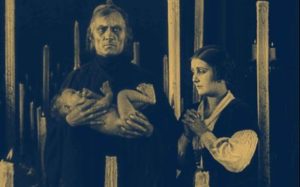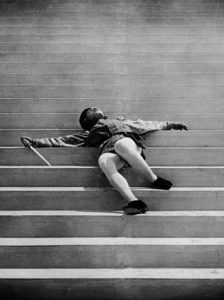STUDIO: Kino Lorber | DIRECTOR: Fritz Lang | CAST: Lil Dagover, Walter Janssen, Bernhard Goetzke, Hans Sternberg, Rudolf Klein-Rogge
RELEASE DATE: 8/30/16 | PRICE: DVD $24.95, Blu-ray $18.00
BONUSES: restoration featurette, audio commentary by film historian Tim Lucas
SPECS: NR | 98 min. | Silent fantasy | 1.33:1 | 2.0 stereo
Up until now, 1921 Destiny has been the only celebrated silent feature by Fritz Lang (Spies, Metropolis) that has been difficult to find in pristine shape. This Kino Lorber release, which contains the Friedrich-Wilhelm-Murnau Stiftung restoration of the 1921 film (constructed from elements that came from six different countries!), fills that gap perfectly.
This restoration allows us to see Lang’s uncategorizable fantasy as it was meant to be seen, with striking imagery, “color coded” tinted visuals and action that situates the film in several genres at once. For Destiny (German title: “The Weary Death”) is at different points a fantasy, a romance “across the centuries,” a period piece, a classically constructed cliffhanger and even a comedy.
 The plot — subtitled “a German folk song in six verses” — is a gender reversal of Orpheus, in which a young woman (Lil Dagover, The Cabinet of Dr. Caligari) pleads with the Grim Reaper (the incredibly ominous-looking Bernhard Goetzke, Dr. Mabuse: the Gambler) to let her fiancé (Walter Janssen) live again.
The plot — subtitled “a German folk song in six verses” — is a gender reversal of Orpheus, in which a young woman (Lil Dagover, The Cabinet of Dr. Caligari) pleads with the Grim Reaper (the incredibly ominous-looking Bernhard Goetzke, Dr. Mabuse: the Gambler) to let her fiancé (Walter Janssen) live again.
The Reaper, who is indeed “weary” of his chores, offers the young woman a bargain: if she can stop the death of her love in other periods in history, he will be brought back to life. After our heroine fails to stop the three “deaths” of her boyfriend in three historical situations (9th-century Bagdad, Venice during the Renaissance, and ancient China), Death provides her with another, more guilt-inducing bargain: find another living soul (preferably very young or very old) to swap for her fiancé.
A scenario like that is obviously rife with “high” melodrama, but Lang and his screenwriter Thea von Harbou (later his wife and the scripter of his greatest German features, including Metropolis and M) did an impressive job of making this cosmic romance into a full-blown entertainment. Each “verse” set in a different location offers a different array of enticements: swashbuckling swordfights, royal intrigue, and comedic scenes involving a magic wand that can turn people into animals (augmented by a flying carpet that directly inspired the one in Fairbanks’ later The Thief of Bagdad and some additional bits of surreal “magic” enacted by a gleeful Dagover).
Harbou’s screenplays for Lang were primarily allegories about good and evil, and Destiny is no different. The film’s “folk song” aspect is underscored by its message, the quote “Love is as strong as death,” from the Song of Solomon. The intertitles are also incredibly long and detailed, although their excessive length is sporadically mitigated by the fact that they are written in special fonts to resemble Arabic, Italian and Chinese.
Despite the melodramatic tone of a good deal of the proceedings, Lang transformed the film into an adventure story that boasts more than a few nail-biting cliffhangers. He and cinematographers Erich Nitzschmann, Herrmann Saalfrank and Fritz Arno Wagner also created haunting images of the afterlife and the three locations in which our heroine tries to alter destiny.
 The most haunting images of all — which one suspects influenced Powell and Pressburger’s A Matter of Life and Death — are those that involve staircases that transport the characters from one realm to another. Lang’s staircases are much like Kubrick’s hallways in The Shining — they are the most impressive images in the film and have the most emotional resonance.
The most haunting images of all — which one suspects influenced Powell and Pressburger’s A Matter of Life and Death — are those that involve staircases that transport the characters from one realm to another. Lang’s staircases are much like Kubrick’s hallways in The Shining — they are the most impressive images in the film and have the most emotional resonance.
The one visual supplement in the package offers a comparison between the previously available B&W version of the film and the new restoration, which brings back the color-coding of the sequences used in the original 1921 release of the film.
Video Watchdog editor Tim Lucas supplies an audio commentary that likens the plot and imagery of Destiny to some of his favorite things — the spaghetti Western, horror anthologies from the British Amicus Studios and the cinema of Mario Bava. Lucas also curiously “Americanizes” the film by comparing its plot to that of the Spider-man mythos and the famous legend about Robert Johnson selling his soul at the crossroads.
Those curious inclusions aside, Lucas’ commentary is most valuable when he discusses the career of Lang, his cast and his technical crew. Most interesting are his mentions of how Lang and Harbou included “reverent” moments in the film, to counteract any claim that their treatment of the afterlife was sacrilegious.
Lucas supplies some great encomiums about Lang and the film, but nothing can match the pullquote used on the package’s cover. The quoted individual notes that Destiny “opened my eyes to the poetic expressiveness of the cinema. When I saw Destiny, I suddenly knew that I wanted to make movies.” This is one of many quotes from the late, great Luis Bunuel about the film.
Given the rarity of a film on Blu-ray or DVD having driven anyone to start making films, it is the ultimate testament to Destiny’s power that it inspired one of the cinema’s greatest artists — who never had any problem with being considered sacrilegious.
|
Buy or Rent Destiny
|
|||
|---|---|---|---|
 |
|||
Leave a Reply